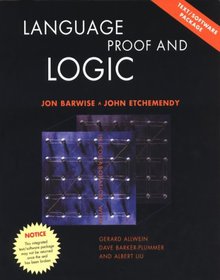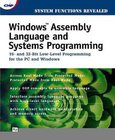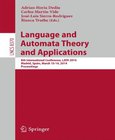Language, Proof and Logic

Book Details:
| Publisher: | Seven Bridges Pr Llc |
| Series: | MIX |
| Author: | Jon Barwise |
| Edition: | 1 |
| ISBN-10: | 1889119083 |
| ISBN-13: | 9781889119083 |
| Pages: | 587 |
| Published: | Aug 01 1999 |
| Posted: | Nov 19 2014 |
| Language: | English |
| Book format: | |
| Book size: | 3.72 MB |
Book Description:
Language Proof and Logic is available as a physical book with the software included on CD and as a downloadable package of software plus the book in PDF format. The all-electronic version is available from Openproof at ggweb.stanford.edu.The textbook/software package covers first-order language in a method appropriate for first and second courses in logic. An on-line grading services instantly grades solutions to hundred of computer exercises. It is designed to be used by philosophy instructors teaching a logic course to undergraduates in philosophy, computer science, mathematics, and linguistics.Introductory material is presented in a systematic and accessible fashion. Advanced chapters include proofs of soundness and completeness for propositional and predicate logic, as well as an accessible sketch of Godel's first incompleteness theorem. The book is appropriate for a wide range of courses, from first logic courses for undergraduates (philosophy, mathematics, and computer science) to a first graduate logic course.The software package includes four programs:Tarski's World 5.0, a new version of the popular program that teaches the basic first-order language and its semantics;Fitch, a natural deduction proof environment for giving and checking first-order proofs;Boole, a program that facilitates the construction and checking of truth tables and related notions (tautology, tautological consequence, etc.);Submit, a program that allows students to submit exercises done with the above programs to the Grade Grinder, the automatic grading service.Grade reports are returned to the student and, if requested, to the student's instructor, eliminating the need for tedious checking of homework. All programs are available for Windows, Macintosh and Linux systems.Instructors do not need to use the programs themselves in order to be able to take advantage of their pedagogical value. More about the software can be found at lpl.stanford.edu.The price of a new text/software package includes one Registration ID, which must be used each time work is submitted to the grading service. Once activated, the Registration ID is not transferable.
Download Link:
Related Books:
Software Abstractions
Logic, Language, and Analysis
In Software Abstractions Daniel Jackson introduces a new approach to software design that draws on traditional formal methods but exploits automated tools to find flaws as early as possible. This approach--which Jackson calls "lightweight formal methods" or "agile modeling"--takes from formal specification the idea of a precise and expressive notation based on a tiny core of simple and robust concepts but replaces conventional analysis based on theorem proving with a fully automated analysis that gives designers immediate feedback. Jackson has developed Alloy, a language that captures the essence of software abstractions simply and succinctly, using a minimal toolkit of mathematical notions. The designer can use automated analysis...
Windows Assembly Language and Systems Programming
16- and 32-Bit Low-Level Programming for the PC and Windows
Language and Automata Theory and Applications
8th International Conference
This book constitutes the refereed proceedings of the 8th International Conference on Language and Automata Theory and Applications, LATA 2014, held in Madrid, Spain in March 2014.The 45 revised full papers presented together with 4 invited talks were carefully reviewed and selected from 116 submissions. The papers cover the following topics: algebraic language theory; algorithms on automata and words; automata and logic; automata for system analysis and program verification; automata, concurrency and Petri nets; automatic structures; combinatorics on words; computability; computational complexity; descriptional complexity; DNA and other models of bio-inspired computing; foundations of finite state technology; foundations of XML; grammars (Chomsky hi...
2007 - 2021 © eBooks-IT.org



